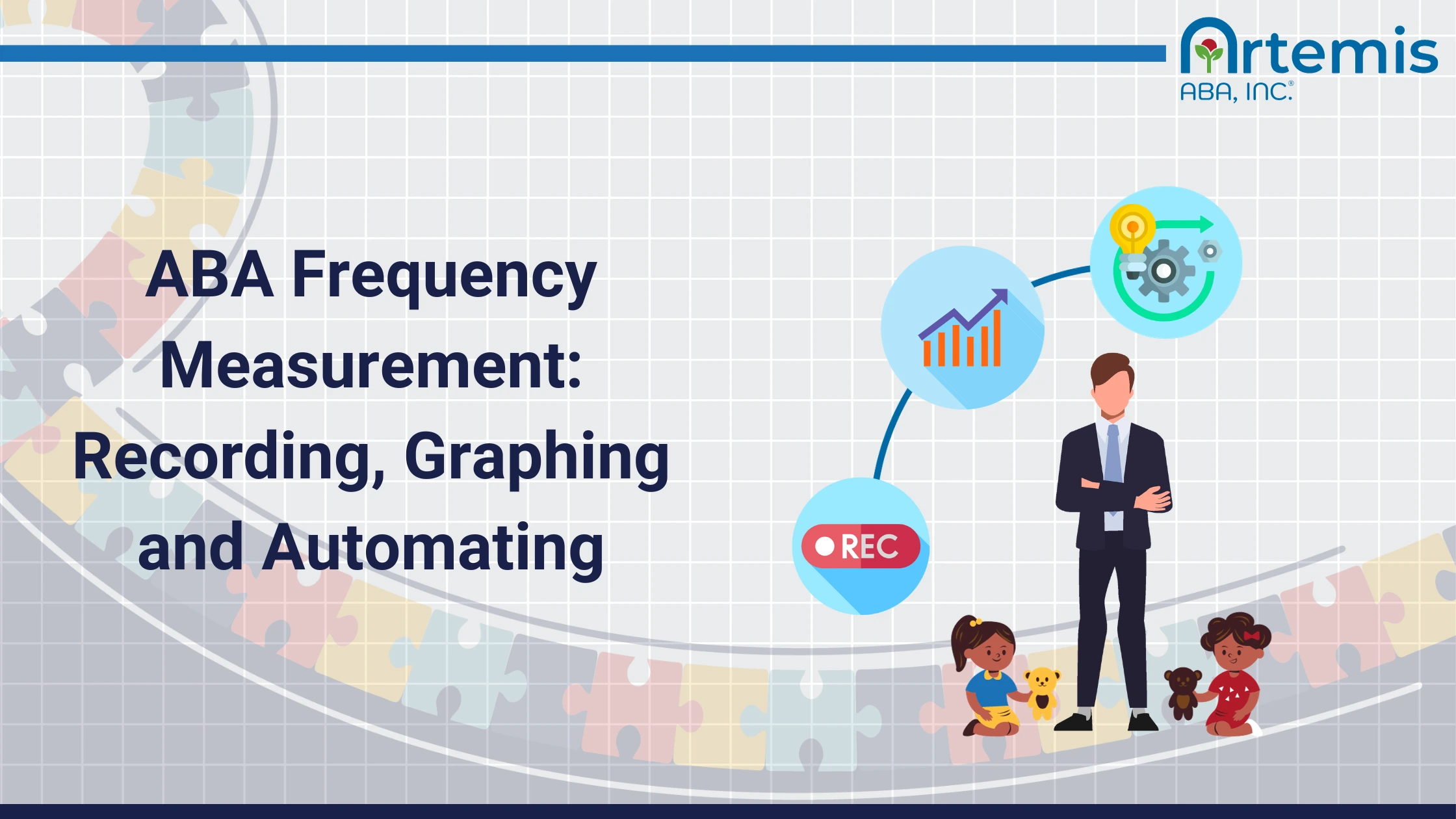Monday to Friday, 7 AM – 7 PM CST.
If you're reaching out outside these hours, please submit a support ticket—our team will respond as soon as possible.

ABA Frequency Measurement: Recording, Graphing, and Automating
A behavior’s frequency plays a key role in analysis and treatment. Explore the importance of frequency data in Applied Behavior Analysis (ABA) and get advice from BCBAs on collecting, graphing, and analyzing it to improve patient outcomes.
Inside this article:
- Examples of frequency in ABA
- Differences between frequency, count, and rate
- How to record frequency in ABA
- Free ABA frequency datasheet templates
- The advantages of electronically collecting frequency data
What is Frequency in ABA Data Collection?
In ABA data collection, “frequency” measures how often a behavior happens. It describes how many times the behavior occurs. Technically, frequency is a count and doesn’t include time, but many BCBAs convert frequency to rate data.
Frequency data is a fundamental metric in ABA. This straightforward metric gives a BCBA the foundational information they need to understand how the behavior fits into the child’s life.
The simplicity of frequency measurement makes it an essential tool for behavior analysts and caregivers alike. By understanding the frequency of behaviors, professionals can develop tailored behavior intervention strategies that lead to more positive outcomes for individuals with behavioral challenges.
Along with other key data, like duration and latency, frequency data is critical to ABA and can serve as the basis for ABA behavior intervention plans.
Key Takeaways:
- Frequency data is a fundamental metric in ABA that captures how often a child engages in a specific behavior.
- Ongoing disagreement exists within the ABA community concerning the terms "count," "frequency," and "rate."
- While frequency is technically a count, most BCBAs and ABA professionals use it like a rate.
- We measure frequency during routine periods with a fixed duration, like an ABA session or class time.
- Frequency data is simple to graph and collect, but measuring accurate data requires much time and attention.
- Electronic ABA data collection improves data collection, monitoring, and analysis.
What is the Difference Between Frequency, Rate, and Count?
Count is a tally of observations, and rate considers the count over time. While textbooks define frequency as a count, behavior analysts almost always use it as a rate. Ongoing discussions continue among ABA experts on this terminology.
There is conflicting information within the ABA community about the term "frequency." Specifically, the textbook definition of the term conflicts with how BCBAs and ABA professionals use the words to describe their work.
To start, here are the technical textbook definitions of “count,” “rate,” and “frequency.”
- Count: A tally of the number of behavior observations. For example: “John hit another student 10 times” is a count.
- Rate: Count data over a specific time interval. For example, “John hit another student 10 times in a two-hour period” is an example of rate data.
- Frequency: Technically synonymous with “count,” frequency measures the number of times someone engages in a specific behavior without considering a time interval.
Many BCBAs view frequency data as a default rate, which contradicts its definition as a count without a specific time interval. This confusion arises because BCBAs often use the term "frequency" when they only record the number of behavior observations during a session of fixed duration. So, in practice, technicians count observations without considering time. But, because they know the session length, they calculate the rate later.
As a result, frequency data is always continuous because the data collector takes data during the entire session. Interval recording, on the other hand, would divide the session into smaller observation periods.
Jester explains how the definition of frequency and its usage can be confusing.
"When we talk about frequency in behavior analysis, we're essentially referring to a simple count of a behavior,” says Jester. “However, it's important to note that in practice, we often utilize frequency data in sessions that have a consistent duration. This allows us to treat frequency as a rate in real-world applications. For example, if we observe Dan's behavior during a three-hour session, we can take the count (frequency) and effortlessly convert it into a rate by considering the three-hour session duration. Therefore, in this context, frequency serves as a rate by default.”
In this sense, frequency is a “rate by default” metric. Collecting frequency data in this way gives BCBAs and technicians the best of both worlds: It eliminates the need to track the observation time period and includes a time interval, making the data more meaningful.
For instance, if we know that John hit a student 10 times, understanding whether he did this within a 30-minute session or over a week significantly influences how we approach interventions and decisions. On the other hand, the simple count “John hit a student 10 times” is far less informative.
The ABA research community has acknowledged this issue, and various researchers have attempted to clarify the distinctions between “frequency,” “count,” and “rate." In the 2016 paper titled "On Terms: Frequency and Rate in Applied Behavior Analysis," the researchers explain that the definitions of these terms contradict how ABA professionals use them in real life. In the article published in The Behavior Analyst, the researchers note that even texts defining frequency as a simple count advise BCBAs to avoid using frequency data without a time.
However, other researchers prefer to adhere to the original textbook definitions. In the 2018 paper titled "On the Use of the Term 'Frequency' in Applied Behavior Analysis," published in the Journal of Applied Behavior Analysis, the authors discuss the issues that arise when ABA technicians use "frequency" as a synonym for both "rate" and "count." They encourage behavior analysts to use frequency as a count, remaining faithful to textbook definitions.
Overall, the issue of defining frequency persists. This article uses the term “frequency” to describe how BCBA analysts collect and analyze frequency data. Specifically, frequency data counts behavior occurrences during a routine session with a fixed duration.
When we use the term “rate,” we refer to collecting frequency data when the technician must also record the observation length, because it’s not a standard session.
When to use Frequency Measurement in ABA?
Utilize frequency measurements in ABA to track how often a child engages in a specific behavior. BCBAs collect them during routine ABA sessions that always are the same length of time. This helps understand behavior patterns over time and evaluate interventions.
Here are the types of behavior and settings that work best for frequency data.
Examples of Frequency in ABA
Examples of frequency data in ABA include any time you count how often a specific behavior occurs. Frequency data helps measure both positive and negative behavior. For example, you can monitor the frequency of tantrums or polite hand-raising.
BCBAs use frequency to measure behavior across the four categories of behavior function. These include sensory behavior, escape-based behavior, attention-based behavior, and tangible-based behavior.
Here are examples of frequency data for each of the four functions of behavior, along with examples of data that people may mistake as frequency data.
How to Record Frequency in ABA
Recording frequency data in ABA is straightforward. Some BCBAs tally the number of occurrences on a specific datasheet. Most BCBAs use electronic data recording where they push a button in the software to record the behavior.
Here are step-by-step instructions for how to record frequency data in ABA.
ABA Frequency Data Sheet Templates
Start collecting frequency data with our free ABA frequency data sheet. It includes sections for all the important data and makes recording frequency easy. Explore this free, printable template to get a feel for recording frequency data.
How to Graph ABA Frequency
To graph frequency data, plot the frequency on the vertical (y) axis and the session dates on the x-axis. The graph shows how often the child engaged in the behavior over the dates you graphed.
Here are the basic steps to graphing ABA frequency by hand or with a standard program.
Alternatively, you can invest in electronic data collection software, which will automatically create graphs based on your data.
- Create vertical and horizontal axes:
Create a graph with the vertical (y) axis showing frequency counts and the horizontal (x) axis indicating the session or observation date. Label your axes and add a clear title to the graph. - Data entry:
Enter the frequency data you collected for each session. - Connect the data:
If you want to use a line graph, you can collect the points you graph to gain a visual representation of behavior frequency changes. - Highlight interventions or changes:
If implementing interventions during the data collection period, use the graph to note these changes. For example, manually write in when you applied an intervention, like discrete trial training, or add it with your practice management software. This practice will help you assess the intervention’s impact on behavior frequency and identify any positive changes. You can highlight other changes in the child’s program that might affect behavior, like medication changes.
Why We Graph ABA Frequency
We graph ABA frequency for visual insight into behavior changes. Graphs display the pace of change and the impact of external factors. They also illustrate progress to the child, caregivers, and funders.
Visual analysis helps us analyze and communicate the meaning of frequency data. Here are the major reasons we graph ABA frequency:
- Visual insights into the trend of a behavior
“Graphs help us determine the trend and variability of the data,” says Jester. "Our goal is to assess if a child exhibits the behavior as intended and if behavior change occurs at an appropriate rate." - Track the effect of a phase change or another intervention
"We also employ graphs to track the impact of external factors, such as medication adjustments, staff transitions, and other events," Jester says. "For instance, noting a shift in intervention phase on a graph helps us assess its influence on behavior frequency. This information is crucial for refining and optimizing the plan to achieve the intended outcome." - Communicate progress to stakeholders
Graphs are more impactful and intuitive than numbers on a sheet. BCBAs and technicians use graphs to illustrate behavior changes to parents and children visually. Also, a good chart can show funders that an intervention is effective and worth investing in.
What are the Advantages of Frequency Recording?
Frequency recording has numerous benefits. It's versatile, easy to use in various settings, and yields clear, objective behavior data. Plus, you can easily graph frequency data and detect changes in behavior quickly.
Here's a summary of the advantages of recording frequency data:
- Straightforward to measure
If you define the behavior well, it’s typically easy to collect frequency data. Make a tally whenever you observe the behavior on a dedicated datasheet or software program. - Easy to analyze
Frequency data isn’t difficult to analyze. It provides a straightforward count of behavior occurrences. - Useful for various settings
Understanding how often the behavior occurs is useful across diverse behaviors and is one of the key metrics that inform how BCBAs design, monitor, and adjust behavior intervention plans. - Simple to graph
Graphing frequency data isn’t complicated, and the graph provides a clear visual representation of behavior patterns that helps ABA professionals analyze the data and communicate with stakeholders.
What are the Limitations of Frequency Recording?
Frequency recording has some drawbacks. It doesn’t capture the context of why a behavior occurs or provide information on how long the child engaged in the behavior. Also, frequency data only works for behaviors with a discrete beginning and end.
Here's a summary of the major limitations of frequency data.
ABA Frequency Recording Best Practices
Follow the established best practices to get the most out of frequency data. For example, clearly define the behavior and consistently use the same observation period. Also, consider collecting data electronically to reduce human error.
Frequency data is a centerpiece of ABA data collection. Ensure you’re getting the most out of this data by following these general best practices for data collection.
- Clearly define your behavior
Jester stresses the significance of well-defined behavior descriptions for accurate frequency data. For example, different children may have specific types of behavior within a generalized category (e.g., kicking, screaming, tantrums). A precise definition for each child will make you confident in the integrity of your data. - Ensure the data collector can focus
Ensuring focused attention is essential for precise frequency data. The data collector mustn’t multitask; otherwise, they might inaccurately record the data. - Maintain the same observation period
In ABA, we collect frequency data in routine sessions with a set duration. Ensure you collect your data within sessions of the same duration. Otherwise, you won’t be able to compare the data across time intervals. - Consider recording the behavior on video to collect data later
Record the session if you can’t give enough attention to the behavior. Later, you can watch the recording with an eye only for the behavior. Also, video records will help you identify intricate or infrequent behaviors and can be a great way to check your data. - Use electronic data collection
Electronic data collection simplifies recording, tracking, and analyzing frequency data. Electronic platforms enable automated data collection, minimize errors, and enhance efficiency by providing instant data storage and analysis.
Using Electronic ABA Data Collection for Frequency Data
Electronic ABA data collection is the best way to collect and analyze frequency data. You can collect data with a simple button push. Then, most systems immediately store, save and graph the data instantly for easy analysis.
Traditionally, behavior analysts relied on manual methods to record the frequency of target behaviors, a process that could be time-consuming and error-prone. Today, most ABA practices have adopted practice management software to digitize all aspects of their ABA practices, including data collection.
When it comes to recording frequency data, electronic data collection holds significant advantages over pen-and-paper methods.
Here's how you can use electronic data collection to improve the frequency of data collection, tracking, and analysis:
Comprehensive, Integrated ABA Data Collection
Effortlessly monitor client progress using Artemis ABA software. Our integrated practice management solution is designed to adapt to your diverse needs. Crafted by ABA experts for experts, Artemis has you covered in comprehensive data collection.
Behavior patterns are complex, and understanding and evaluating behavior data requires a tool that’s up for the job. Artemis ABA software offers comprehensive ABA data collection where you can conveniently record and analyze duration, latency, and frequency in a single platform. This software allows ABA therapists to effectively utilize the collected data to monitor client development and make well-informed treatment decisions.
Our practice management solution is adaptable and can be tailored to suit the specific requirements of your ABA practice, unlike other ABA software. Artemis ABA is a one-stop shop, with every aspect of practice management integrated under one centralized location. This streamlined approach facilitates easy access, analysis, and visualization of your data, ensuring a seamless experience for users.
Schedule Your Walkthrough
Please enter your details and one of our team members will contact you shortly
See Artemis in Action
Enter your information below















%201.webp)


